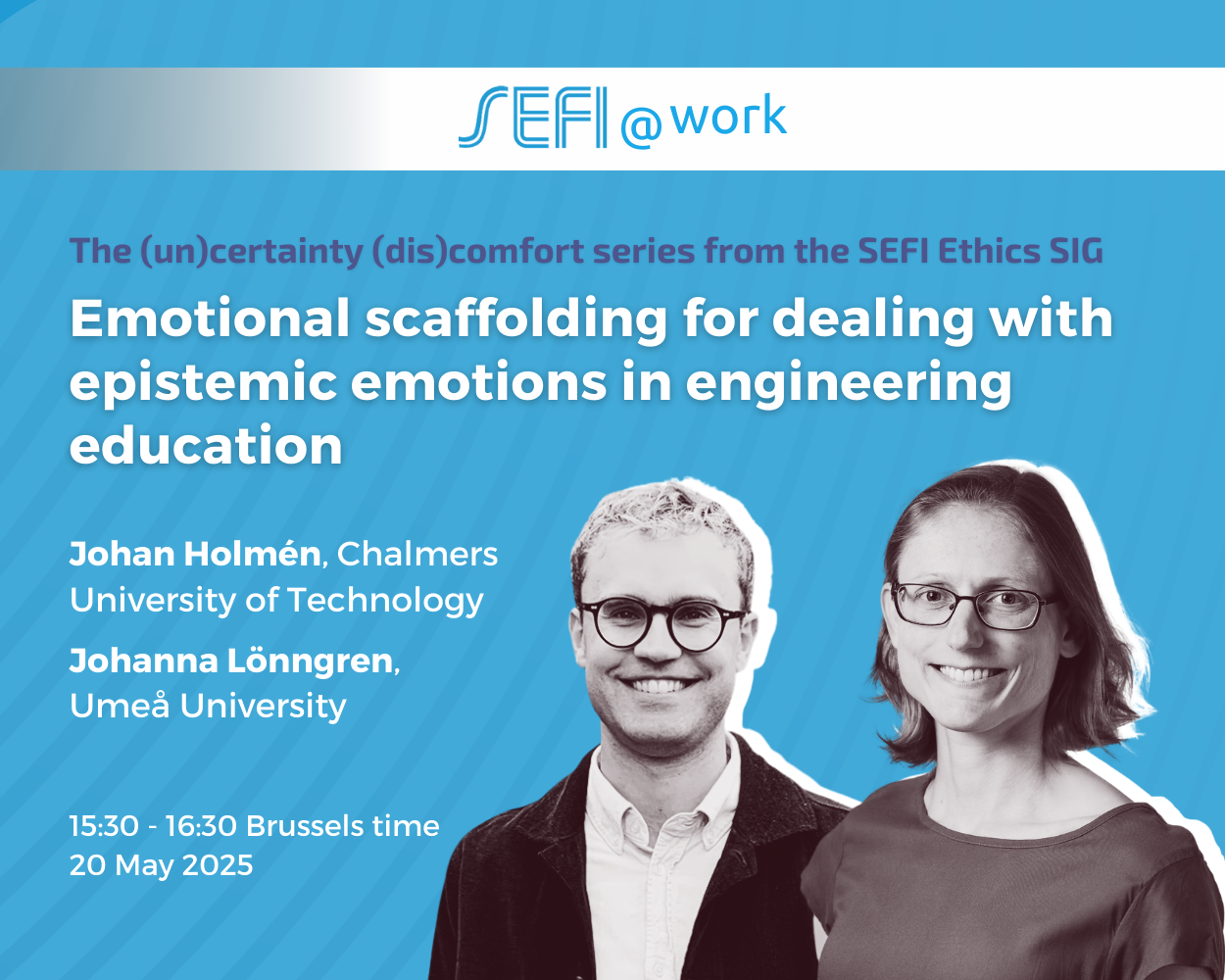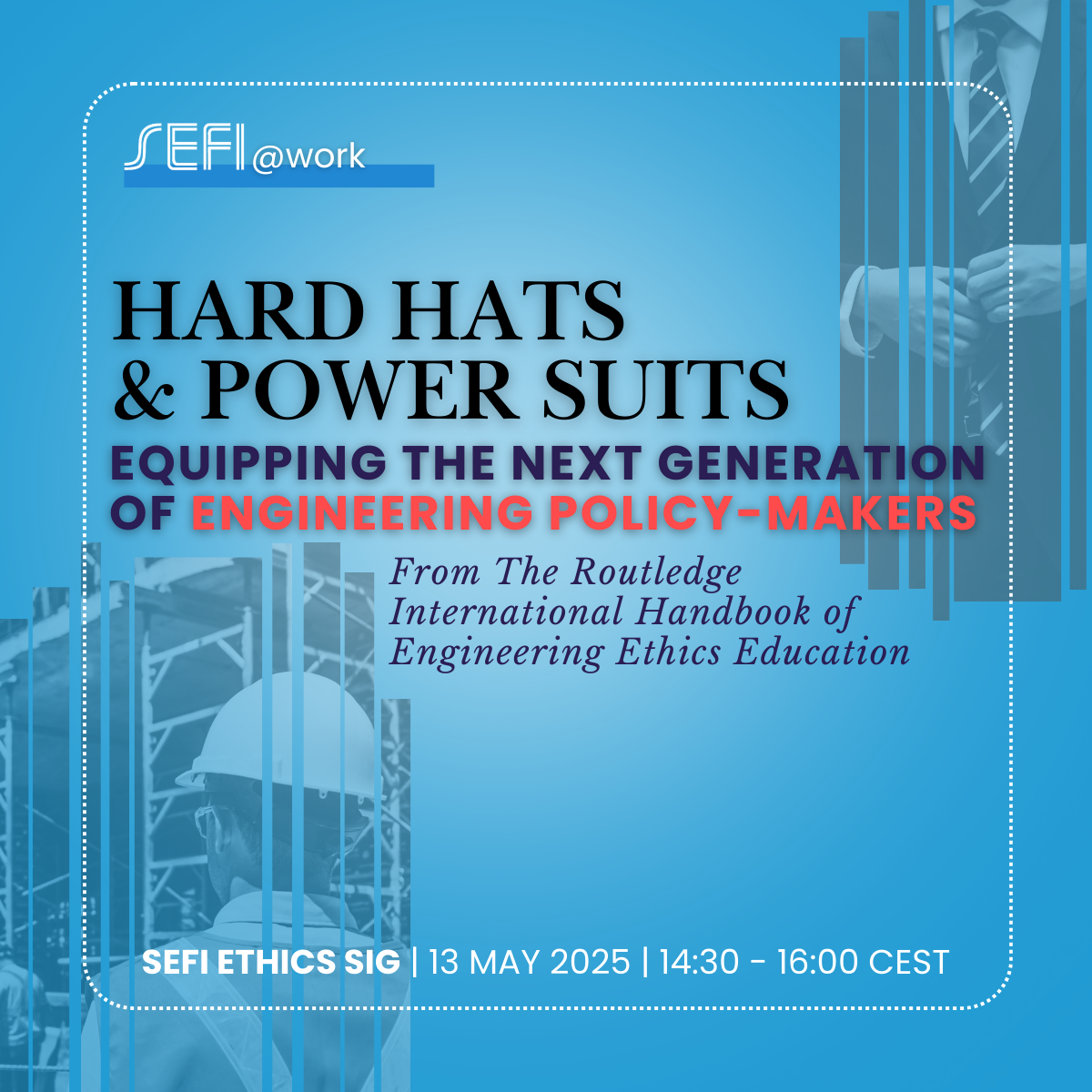UPDATE: We sincerely thank all participants for their interest in the 2025/26 intake. The survey…
Teaching Engineering Ethics Online: Between Adaptation and Transformation
The SEFI Ethics SIG Working Group organised an online workshop on “Teaching Engineering Ethics Online: Between Adaptation and Transformation” on 9 September 2020. 51 people from all five continents joined the session which say five thought-provoking presentations discussed.
Justin Hess (Purdue University, USA) in his presentation “Considerations for teaching engineering ethics in an online modality”explained how he used backward design to focus on empathy in his ethics online courses. In recent research, Justin and his colleagues found that students scored higher on ethical reasoning (measured by the EERI, Engineering Ethical Reasoning Instrument), but had lower satisfaction. This made him conclude that most ‘in-class’ instructional and assessment strategies are directly transferrable to online modalities. One critical consideration, however, is lower scores on interactivity. Students may feel isolated in online settings, so find ways for students to interact with their peers and to develop a sense of community.
Maha Bali (University of Cairo, Egypt) explained two methods that are applicable online to raise student involvement online. “Theatre of the Oppressed” is a theatre technique or a game that seeks to motivate people, restore true dialogue, and create space for participants to rehearse taking action. It brings engineering students in a practice case and asks them to play how the case works out. Maha also explained a huge menu of “Liberating Structures” options. Liberating structures are easy-to-learn microstructures that enhance relational coordination and trust quickly fostering lively participation. She practiced the “TRIZ Process”: (1) Make a list of all you can do to make sure that you achieve the worst result imaginable. (2) Go down the list and ask yourself “Are we doing this right now?” and make a list of all your counterproductive activities. (3) Decide first steps to answer the second list. More on https://oneheglobal.org/equity-unbound. Maha’s presentation is available here.
Gabriel Burks (University of Illinois Urbana-Champaign, USA) in “Using human-centered design in online teaching and engineering ethics instruction” showed how he and his colleagues brought in new local environments. They for example used TikTok and measuring movement devices to compare each other dancing styles in a biomedical technology course. He concluded that, by providing learners with a framework for local environments engagement, a new level of concept negotiation and a more contextualized presentation of STEM theory can e attained within virtual teaching and learning spaces. When applied to engineering ethics, this will inevitably strengthen their connection to those who are generally impacted by their decisions. When this occurs, engineers experience a shift from viewing ethics as a series of general best practices to fully embodying what it means to be a responsible human that other humans rely on. Important Lesson learnt: keep the focus on students, also in developing (not what works best for teacher). Gabriel’s presentation is available here. More on https://news.illinois.edu/view/6367/576642497
Kristina Masuwa-Morgan (University of Greenwich, UK) in “Metering out the Sustainable futures agenda in engineering education” discussed the sustainability literacy tool Sulitest and in particular the Engineering Sustainable Development mapping tool. This easy rubric makes it possible to analyse global citizenship, environmental stewardship, social justice-ethics-well being, and futures thinking in different phases of the course or curriculum design like prospectus, website, or program communication. She illustrated how she uses the Sulitest measures online. Students do the quiz on Sulitest. Four factors emerge for the students: knowledge ecosystems; knowledge on global-local human constructed systems; knowledge on role to play, individual and systemic change; and knowledge on transition towards sustainability). After that, students are graded on the self-reflection that they learn from this. So, the quiz itself is formative, the self-reflection is summative.
Iain Skinner (UNSW Sydney, Australia) talked about “Whole of class reflection on ethics prompted by online data collection”. In a first example, Iain described how students had to make 6 pairwise comparisons between 4 sustainability criteria (environmental, social, cultural and economic). Analytic design hierarchy provided preferences to weightings of relative importance. The results were then used to discuss conceptualization (What does “cultural” mean?), often for students already difficult to accept that different conceptualizations can exist next to each other; to discuss differences in average between criteria; and to discuss large spread, for example of the criterion “economic”. Another example asked students to choose one out of four applications to join project team and asked to rank them. One group received names (referring to gender or ethnicity), the other group received them de-identified. The strong differences indicate prejudices in the student group. In both cases, Iain concludes, students are surprised (and surprised that they are surprised); they accept the topic as valid given the results and the variations; and they start reflecting on themselves and their fellow group members raising self-awareness.


